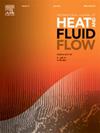A novel three-dimensional topology-optimized cold plate design for lithium-ion battery thermal management based on Murray’s law
IF 2.6
3区 工程技术
Q2 ENGINEERING, MECHANICAL
International Journal of Heat and Fluid Flow
Pub Date : 2025-07-29
DOI:10.1016/j.ijheatfluidflow.2025.109997
引用次数: 0
Abstract
The flow channel design of liquid cold plates is a critical aspect of battery thermal management systems. This study aims to develop a novel 3D topology-optimized cold plate design method based on Murray’s law to enhance the thermal management performance of lithium-ion batteries. To address the limitations of the conventional approach that directly stretches 2D topology optimization results to form 3D cold plates, a new design strategy involving secondary optimization based on Murray’s law is proposed to generate scientifically improved 3D cold plate structures. Numerical simulations are employed to systematically investigate the effects of cold plate type, inlet mass flow rate, coolant and ambient temperatures, and channel depth on the performance of the cold plates. The optimal channel depth for each hydraulic diameter is identified. The results indicate that, under identical conditions, the optimized cold plate (OP) achieves a heat transfer coefficient improvement of up to 122.12 % compared to the conventional stretched plate (SP), significantly enhancing battery temperature control. Moreover, the Performance Evaluation Criterion (PEC) of the OP increases by up to 55.36 % relative to the SP, and can be further improved by 34.84 % through channel depth optimization. The study also reveals that for each inlet hydraulic diameter, the optimal channel depth is 0.5 mm greater than that of the corresponding SP. This research provides a new optimization approach and methodology for the efficient design of cold plates in lithium-ion battery thermal management systems.
基于Murray定律的锂离子电池热管理三维拓扑优化冷板设计
液冷板的流道设计是电池热管理系统的一个重要方面。本研究旨在开发一种基于Murray定律的三维拓扑优化冷板设计方法,以提高锂离子电池的热管理性能。针对传统方法直接拉伸二维拓扑优化结果形成三维冷板的局限性,提出了一种基于Murray定律的二次优化设计策略,生成科学改进的三维冷板结构。采用数值模拟方法系统地研究了冷板类型、进口质量流量、冷却剂和环境温度以及通道深度对冷板性能的影响。确定了各水力直径下的最优通道深度。结果表明,在相同条件下,优化后的冷板(OP)传热系数比传统的拉伸板(SP)提高了122.12%,显著提高了电池的温度控制能力。此外,OP的性能评价标准(PEC)相对于SP提高了55.36%,通过通道深度优化可进一步提高34.84%。研究还发现,对于每个进口液压直径,最佳通道深度比相应的SP大0.5 mm。该研究为锂离子电池热管理系统中冷板的高效设计提供了新的优化方法和方法。
本文章由计算机程序翻译,如有差异,请以英文原文为准。
求助全文
约1分钟内获得全文
求助全文
来源期刊

International Journal of Heat and Fluid Flow
工程技术-工程:机械
CiteScore
5.00
自引率
7.70%
发文量
131
审稿时长
33 days
期刊介绍:
The International Journal of Heat and Fluid Flow welcomes high-quality original contributions on experimental, computational, and physical aspects of convective heat transfer and fluid dynamics relevant to engineering or the environment, including multiphase and microscale flows.
Papers reporting the application of these disciplines to design and development, with emphasis on new technological fields, are also welcomed. Some of these new fields include microscale electronic and mechanical systems; medical and biological systems; and thermal and flow control in both the internal and external environment.
 求助内容:
求助内容: 应助结果提醒方式:
应助结果提醒方式:


